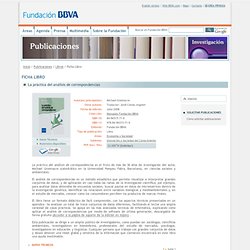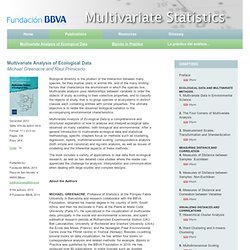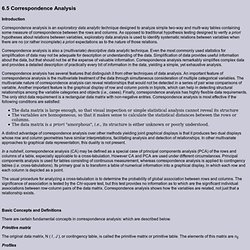

ABC de la méthodologie de la recherche - Cours de recueil, analyse et traitement de données. L'analyse de données définie ici au sens large est un ensemble de méthodes ayant pour objectif la modélisation, le recueil et le traitement des données. Son objectif est de rassembler un ensemble d'éléments quantitatifs et qualitatifs pour en extraire l'information utile : par exemple valider une hypothèse ou aider à la prise de décision. - Les chapitres suivants des ces cours de méthodologie sont en ligne sur ma chaîne Youtube Ces cours en diapositives animées, vidéo, pptx, pdf sont distribués sous licence Creative Commons : à condition de me citer et de mettre un lien vers cette page, vous pouvez les réutiliser ou les modifier dans un cadre non-commercial, (à l'exception des images) mais vous devez ensuite les publier aux mêmes conditions. 1. 2. 3. 3. 1. 2. 3.
. · Cours pas à pas intitulé «l'AFC pour les nuls » en pdf et pptx Pour mieux les mémoriser, voici des cartes conceptuelles résumant certains des cours. Libro - La práctica del análisis de correspondencias. La práctica del análisis de correspondencias es el fruto de más de 30 años de investigación del autor, Michael Greenacre (catedrático en la Universidad Pompeu Fabra, Barcelona), en ciencias sociales y ambientales.

El análisis de correspondencias es un método estadístico que permite visualizar e interpretar grandes conjuntos de datos, y de aplicación en casi todas las ramas de la investigación científica; por ejemplo, para analizar datos obtenidos de encuestas sociales, buscar pautas en datos de micromatrices dentro de la investigación genética, identificar las relaciones entre variables biológicas y medioambientales y, en el estudio de mercados, conocer cómo los consumidores perciben los productos de marcas rivales.
El libro tiene un formato didáctico de fácil comprensión, con los aspectos técnicos presentados en un apéndice. Multivariate Statistics. Biological diversity is the product of the interaction between many species, be they marine, plant or animal life, and of the many limiting factors that characterize the environment in which the species live.

Multivariate analysis uses relationships between variables to order the objects of study according to their collective properties, and to classify the objects of study, that is to group species or ecosystems in distinct classes each containing entities with similar properties. The ultimate objective is to relate the observed biological variation to the accompanying environmental characteristics.
Multivariate Analysis of Ecological Data is a comprehensive and structured explanation of how to analyse and interpret ecological data observed on many variables, both biological and environmental. About the Authors. Correspondence Analysis. Correspondence analysis provides a graphic method of exploring the relationship between variables in a contingency table.

There are many options for correspondence analysis in R. I recommend the ca package by Nenadic and Greenacre because it supports supplimentary points, subset analyses, and comprehensive graphics. You can obtain the package here. Although ca can perform multiple correspondence analysis (more than two categorical variables), only simple correspondence analysis is covered here. See their article for details on multiple CA. In the following example, A and B are categorical factors. # Correspondence Analysis library(ca) mytable <- with(mydata, table(A,B)) # create a 2 way table prop.table(mytable, 1) # row percentages prop.table(mytable, 2) # column percentages fit <- ca(mytable) print(fit) # basic results summary(fit) # extended results plot(fit) # symmetric map plot(fit, mass = TRUE, contrib = "absolute", map = "rowgreen", arrows = c(FALSE, TRUE)) # asymmetric map. A Gentle Introduction to Correspondence Analysis. There are some digital humanists who are competent mathematicians, but most of us experience some anxiety about the more advanced mathematics involved in the text analysis methodologies that we use.

Dammit Jim, I’m a humanist, not a mathematician! The problem of course is that there are clearly some statistical and graphical techniques that can be very powerful for humanities research (if you’re unconvinced by this claim, please read on anyway). So one faces a choice: not using these techniquesusing these techniques naïvely and trusting that they’re working properly and that one is interpreting the results properlyinvesting a ton of time learning the mathematics involved, sometimes to the detriment of the original research agendacollaborating with someone who does understand the mathematics Correspondence Analysis is a good example of a technique that can appear very intimidating but that can also be a very powerful tool in the arsenal of a digital humanist. Some useful links: Correspondence Analysis. 6.5 Correspondence Analysis Introduction Correspondence analysis is an exploratory data analytic technique designed to analyze simple two-way and multi-way tables containing some measure of correspondence between the rows and columns.

As opposed to traditional hypothesis testing designed to verify a priori hypotheses about relations between variables, exploratory data analysis is used to identify systematic relations between variables when there are no (or rather incomplete) a priori expectations as to the nature of those relations. Correspondence analysis is also a (multivariate) descriptive data analytic technique. Even the most commonly used statistics for simplification of data may not be adequate for description or understanding of the data.